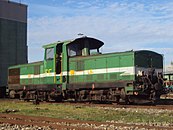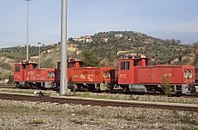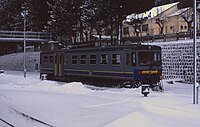Ferrovie Calabro Lucane
The Ferrovie Calabro Lucane (FCL) were a railway company in the four southern Italian regions of Campania , Basilicata , Apulia and Calabria . They consisted 1964-1990 and operated narrow-gauge railways with 950 mm gauge and bus lines.
history
In 1910, the Mediterranea-Calabro-Lucane (MCL) received a concession to build a branch line network in southern Italy with a gauge of 950 mm . The MCL, at that time still with its original name Rete Mediterranea , had lost its standard gauge network after the nationalization in 1905 , but received large sums of money. The original ambitious project wanted to connect the provinces of Salerno , Potenza , Matera , Bari , Cosenza , Catanzaro and Reggio Calabria . On August 9, 1915, the Bari - Matera line was the first section to be opened to traffic. The First World War delayed the construction work. In 1926 the network was reduced to the routes that had already begun and in 1934 construction work was stopped entirely. 765 kilometers of the dismembered network were in operation. The MCL neglected modernization and maintenance, which was also the reason for the serious accident on the Fiumarella Viaduct on December 23, 1961, in which 71 people lost their lives.
After the accident, the MCL's license was revoked and granted to Ferrovie Calabro Lucane (FCL) on January 1, 1964. The FCL was under the direction of a government commissioner. The main administration was in Rome , the finance department in Bari and Catanzaro . The rapid development of road traffic in the 1960s led to a severe slump in traffic on the outdated narrow-gauge railways. In 1969 it was decided to adapt the infrastructure of the FCL to the traffic needs of the population. Rail routes with low demand have been discontinued and replaced by bus routes. For this purpose the FCL procured several hundred buses.

With a decree on October 2, 1990, the FCL was divided into two companies. The Ferrovie della Calabria (FC) took in 1991 to train and bus service in the region of Calabria, and the Ferrovie Appulo Lucane (FAL) took over the public transport in the regions of Basilicata and Puglia.
business
The narrow-gauge FCL routes leading through mountainous areas, with their tight curves and gradients of up to 60 per thousand, only allowed low speeds, averaging around 30 km / h. Sections of the route with a gradient of 100 per thousand were negotiated with a rack . The train journeys were initially secured by telegraph or telephone . Typical of the FCL disc signals were from the station through interlocking of types Jüdel and AEG of the Italian licensee Officine Meccaniche Servettaz served. It was not until the late 1980s that the first push-button interlockings were used on the main lines .
FCL routes
| route | length | Company opening | attitude | |
|---|---|---|---|---|
| Bari – Matera – Montalbano Jonico | 141.165 km | |||
| ● Bari - Matera | 75,800 km | August 9, 1915 | - | |
| ● Matera - Miglionico | 27.708 km | May 24, 1928 | 1972 | |
| ● Miglionico– Montalbano Jonico | 37.656 km | October 29, 1932 | ||
| Altamura – Avigliano Lucania | 85.291 km | - | ||
| ● Acerenza - Avigliano Lucania | 19.188 km | May 26, 1930 | - | |
| ● Altamura -Acerenza | 66.103 km | April 21, 1934 | - | |
| Avigliano Città – Potenza – Laurenzana | 64.778 km | |||
| ● Potenza Inferiore Scalo - Pignola | 12,130 km | January 23, 1919 | 1980 | |
| ● Avigliano Città – Avigliano Lucania | 7.716 km | May 26, 1930 | - | |
| ● Pignola - Laurenzana | 30.370 km | November 4, 1931 | 1969 | |
| ● Potenza Città – Potenza Inferiore Scalo | 3.083 km | July 1, 1933 | - | |
| ● Potenza Città – Avigliano Lucania | 11.477 km | October 28, 1933 | - | |
| Ahtena - Marsico Nuovo | 26.764 km | October 28, 1931 | 1966 | |
| Lagonegro – Spezzano Albanese in sections with rack | 104,745 km | |||
| ● Spezzano Albanese - Castrovillari | 25.254 km | September 15, 1915 | 1978 | |
| ● Lagonegro - Laino Borgo | 39.857 km | October 30, 1929 | ||
| ● Castrovillari– Morano Calabro | 3.377 km | June 23, 1930 | ||
| ● Laino Borgo – Morano Calabro | 32.255 km | July 1, 1931 | ||
| Cosenza-Pedace-Catanzaro | 109.824 km | - | ||
| ● Cosenza - Pedace - Rogliano | 23.240 km | October 9, 1916 | - | |
| ● Rogliano– Soveria Mannelli | 35.484 km | October 11, 1922 | - | |
| ● Soveria Mannelli - Decollatura | 6.338 km | March 30, 1924 | - | |
| ● Catanzaro Città – Catanzaro Lido a section with a rack |
11.121 km | July 10, 1933 | - | |
| ● Decollatura – Catanzaro Città | 33.639 km | June 18, 1934 | - | |
| Pedace – San Giovanni in Fiore | 67.084 km | |||
| ● Pedace– Spezzano della Sila | 10.460 km | October 11, 1922 | 2010 | |
| ● Spezzano della Sila - San Pietro in Guarano | 11.352 km | 2008 | ||
| ● San Pietro in Guarano - Camigliatello Silano | 17.582 km | August 10, 1931 | ||
| ● Camigliatello Silano - San Giovanni in Fiore | 27.690 km | May 6, 1956 | 1997 | |
| Crotone-Petilia Policastro | 41.841 km | |||
| ● Crotone Centro - Bivio Porto - Petilia Policastro | 40.666 km | June 16, 1930 | 1972 | |
| ● Bivio Porto – Crotone Porto | 1.175 km | 2nd August 1930 | ||
| Vibo Valentia – Mileto | 27.881 km | |||
| ● Vibo Valentia Marina - Vibo Valentia Città | 14.887 km | July 2, 1917 | 1966 | |
| ● Vibo Valentia Città - Mileto | 12.993 km | 4th October 1923 | ||
| Soverato – Chiaravalle Centrale | 22,950 km | December 15, 1923 | 1969 | |
| Gioia Tauro-Cinquefrondi | 31.737 km | |||
| ● Gioia Tauro - Cittanova | 21.219 km | June 1, 1924 | 2011 | |
| ● Cittanova– Cinquefrondi | 10.518 km | March 28, 1929 | ||
| Gioia Tauro-Palmi-Sinopoli | 26,280 km | |||
| ● Gioia Tauro - Palmi | 12.975 km | January 18, 1917 | 2011 | |
| ● Palmi - Seminara | 1994 | |||
| ● Seminara - Sinopoli | 13.307 km | April 21, 1928 | ||
| Marina di Giojosa – Mammola | 14.514 km | August 1, 1931 | 1968 | |
| Total | 737.173 km | |||
Traction vehicles
Ferrovie Calabro Lucane (FCL) took over the M1c "Emmina" rail buses with rack-and- pinion drive and the M2.120 diesel multiple units for passenger transport from its predecessor MCL . In addition, u. a. the steam locomotives of the 400 series for adhesion operation and the 500 series with adhesion and gear drive are available.
To modernize the rolling stock, the FCL procured the following series:
38 M2.200 diesel multiple units
9 LM4 diesel locomotives
3 LM2.700 rack-and-pinion locomotives
15 M4.300 diesel multiple units
literature
- Hansjürg Rohrer: The routes of the Ferrovie Calabro – Lucane (FCL) around Gioia Tauro . In: Wolfgang Messerschmidt (Ed.): Locomotive magazine . No. 74 . Franckh'sche Verlagshandlung, W. Keller & Co. , 1975, ISSN 0458-1822 , p. 409-410 .
- Riccardo Giraldi: Il popolo cosentino e il suo territorio. The population of Cosenza and their territory. Cosenza, Publishing House Luigi Pellegrini, 2003 (Italian)
- Storia. History. Homepage of Ferrovie della Calabria, accessed on December 15, 2017 (Italian)
- Roberto Troiano: Breve storia delle FCL: Brief history of the FCL. From: www.webalice.it, accessed December 15, 2017 (Italian)
- Bibliografia Ferroviaria Italiana. Italian railway bibliography . Chronological overview of the railway lines opened from 1839 to December 31, 1926, February 6, 2014 (Italian)





